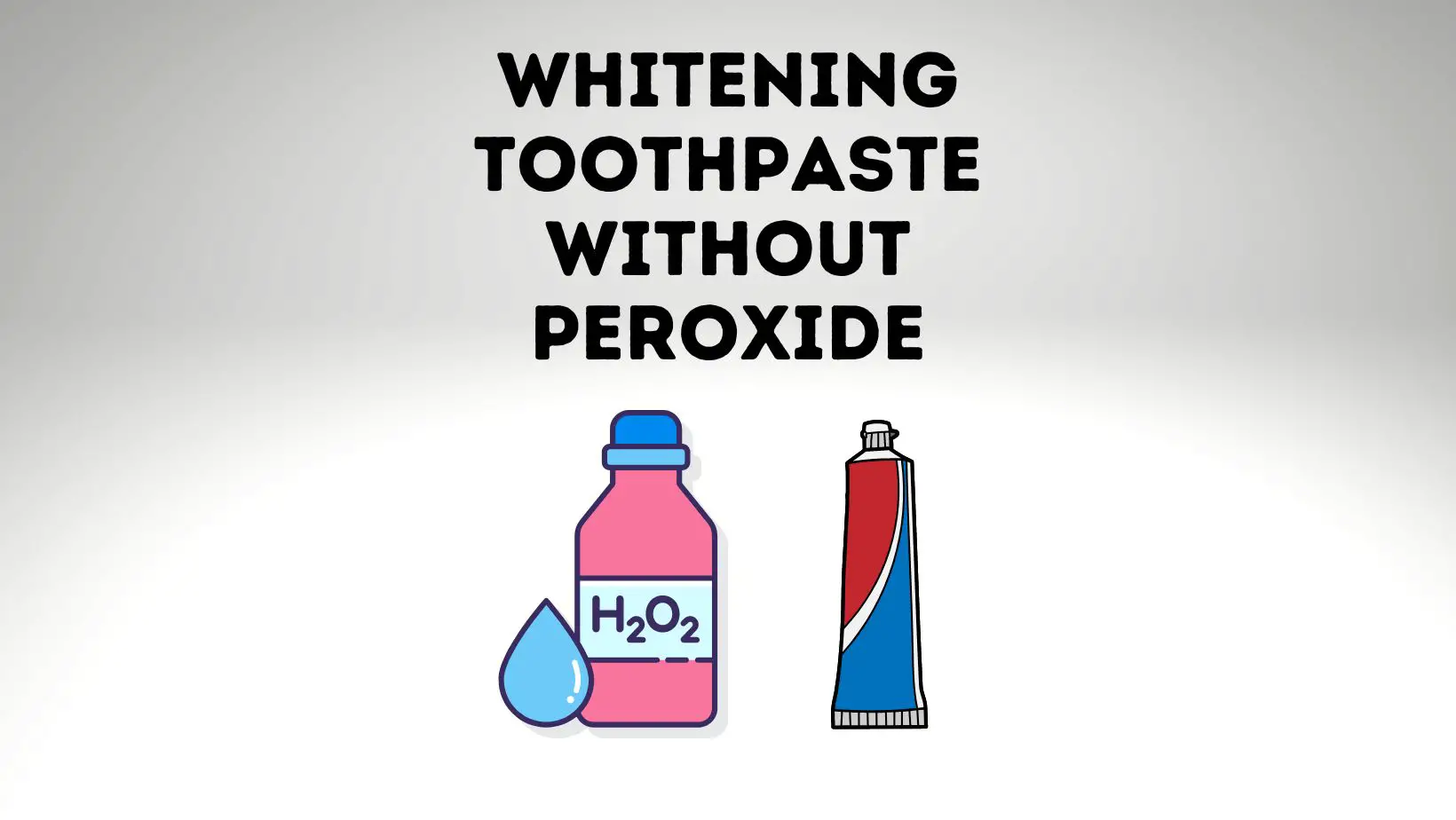
Toothpaste is an essential product for oral hygiene and has been used for centuries. It is essential for removing plaque and preventing tooth decay. There are two main types of toothpaste – those with Peroxide and those without.
Toothpaste with Peroxide is a bleaching agent that removes surface stains. Peroxide is commonly used in toothpaste to achieve whiter teeth and to eliminate surface stains caused by food, drinks, and smoking.
On the other hand, toothpaste without Peroxide is a gentler alternative for those with sensitive teeth or gums. This type of toothpaste is formulated to clean teeth without causing any discomfort or irritation. It is also a good choice for those who have had dental treatments. Toothpaste without Peroxide is ideal for use after bonding, veneers, or crowns. This is because Peroxide can weaken the bond between the tooth and the restoration.
So, which type of toothpaste is better – Peroxide or non-peroxide?
The answer depends on an individual’s needs and preferences. For those who want to achieve whiter teeth, peroxide toothpaste may be a good option. However, non-peroxide toothpaste may be the better choice for those with sensitive teeth or gums.
It is also important to note that peroxide toothpaste should not be used on a daily basis, as it can lead to over-bleaching and damage the enamel on your teeth.
Peroxide, Its Usage, and Benefits
Peroxide is a common ingredient used in many dental and cosmetic products, including toothpaste, mouthwash, and hair bleach. Here are some of its key uses and benefits:
- Teeth whitening: Peroxide is a popular ingredient in teeth whitening products because it can remove surface stains and brighten the teeth.
- Dental hygiene: Peroxide-based mouthwashes and toothpaste effectively kill bacteria, reduce plaque, and freshen your breath.
- Wound care: Peroxide is a strong antiseptic and can be used to clean and disinfect cuts, scrapes, and wounds.
- Acne treatment: Peroxide has been used for decades as an acne treatment because it can help dry out pimples and reduce inflammation.
- Hair lightening: Peroxide can be used as a hair bleach to lighten natural hair color or to remove hair dye.
Consequences of Peroxide in Toothpaste
It is important to note that while Peroxide can have many benefits, it can also cause side effects and consequences.
Overuse or prolonged exposure to Peroxide can have some negative consequences. Here are some of the potential consequences of Peroxide in toothpaste:
- Tooth sensitivity: Overuse of peroxide toothpaste can lead to tooth sensitivity as the Peroxide can weaken the enamel on the teeth.
- Enamel damage: Peroxide can cause damage to the enamel on the teeth, making the teeth more susceptible to decay and sensitivity.
- Irritation: Peroxide can cause irritation and redness of the gums, especially for people with sensitive gums.
- Over-bleaching: Using peroxide toothpaste on a daily basis can lead to over-bleaching and unnatural-looking teeth.
- Incompatibility with dental treatments: Peroxide toothpaste can weaken the bond between the tooth and dental restorations, such as bonding, veneers, and crowns.
It is important to be cautious when using peroxide toothpaste and follow the product’s instructions. It is also a good idea to consult with your dentist to determine the best toothpaste for your specific oral health needs.
Whitening Toothpaste Without Peroxide- Are They Equally Effective?
Whitening toothpaste without Peroxide is a gentler alternative for those with sensitive teeth or gums. They are formulated to clean teeth and remove surface stains without causing any discomfort or irritation. These toothpaste contain mild abrasives and natural ingredients, such as baking soda and charcoal, to gently polish the teeth and remove stains.
But are they effective in achieving whiter teeth? The answer is yes and no.
Non-peroxide whitening toothpaste can help remove surface stains, but they are not as effective as toothpaste with Peroxide in removing deep-set or intrinsic stains. These toothpaste work by physically removing surface stains through gentle abrasives, but they do not contain the bleaching agents found in peroxide toothpaste.
Non-peroxide whitening toothpaste is a good option for those with sensitive teeth or gums, but it may not be as effective as peroxide toothpaste in achieving whiter teeth. It is always best to consult with your dentist to determine the best toothpaste for your specific oral health needs. Your dentist can recommend the best toothpaste for your specific oral needs based on your oral health, medical history, and lifestyle habits.
Toothpaste Ingredients Besides Peroxide That Aids In Teeth Whitening
There are several ingredients in toothpaste besides Peroxide that can help to whiten teeth and remove surface stains. Here are some of the most common:
- Baking soda: Baking soda is a natural whitening agent and mild abrasive that can help remove surface stains on the teeth.
- Charcoal: Activated charcoal is a popular ingredient in whitening toothpaste because it can adsorb surface stains and help whiten the teeth.
- Hydrogen peroxide: While not as strong as Peroxide, hydrogen peroxide is still an effective whitening ingredient and can help remove surface stains.
- Calcium carbonate: Calcium carbonate is a gentle abrasive that can help remove surface stains on the teeth.
- Silica: Silica is a mild abrasive that can help remove surface stains on the teeth and promote a brighter, whiter smile.
Best Non-Peroxide/ Peroxide Free Whitening Toothpaste 2023
Colgate Total Whitening Toothpaste with Stannous Fluoride and Zinc

Lumineux Teeth Whitening Toothpaste

Hello Naturally Whitening Fluoride Toothpaste, Natural Peppermint Flavor, and Tea Tree Oil, Peroxide Free, Gluten Free, SLS Free

Burt’s Bees Toothpaste, Natural Flavor, Charcoal Fluoride-Free Toothpaste

Is Peroxide-Free Toothpaste ADA-Approved?
Yes, peroxide-free toothpaste can be ADA (American Dental Association) approved. The ADA evaluates and seals toothpaste that meets its standards for safety and efficacy.
Making A Whitening Toothpaste At Home- Without Peroxide
Here is a recipe for a homemade whitening toothpaste without hydrogen peroxide:
Ingredients:
- 2 tablespoons baking soda
- 1 tablespoon coconut oil
- 1 teaspoon lemon juice or fresh mint leaves
Instructions:
- Mix the baking soda and coconut oil in a small bowl until it forms a paste.
- Add the lemon juice or finely chopped mint leaves.
- Store the toothpaste in a small container and use it as needed.
Note: It is always important to use baking soda in moderation and not to use it more than a few times a week, as it can be abrasive to the enamel of your teeth. You should also always follow good oral hygiene practices, including brushing for two minutes twice a day and flossing daily.
Wrapping up…
In conclusion, peroxide-free whitening toothpaste is a safe and effective alternative for people who want to achieve a brighter smile without using hydrogen peroxide. These toothpastes can remove surface stains and improve the overall appearance of your teeth, but results may vary.
It’s important to choose an ADA-approved toothpaste that meets the standards for safety and efficacy. You can find a list of approved toothpaste on the official website of the American Dental Association. Additionally, maintaining good oral hygiene practices like brushing twice a day and flossing daily can help enhance the effects of your whitening toothpaste and maintain a healthy smile.

Hi, This is Lyn, I suffer from dental sensitivity for a very long time. PowerToothpaste.com is where I share my views of various toothpaste brands, along with tips on how to use toothpaste and what to look for when purchasing.
